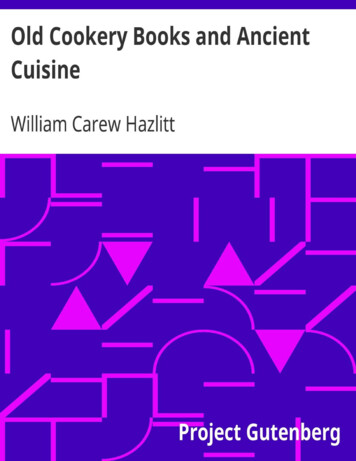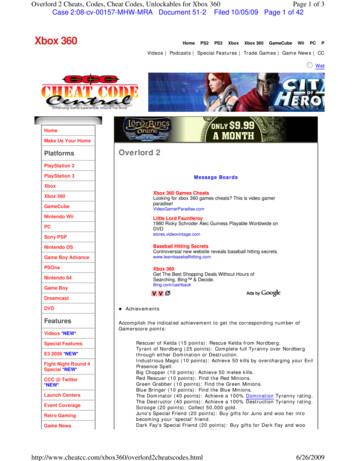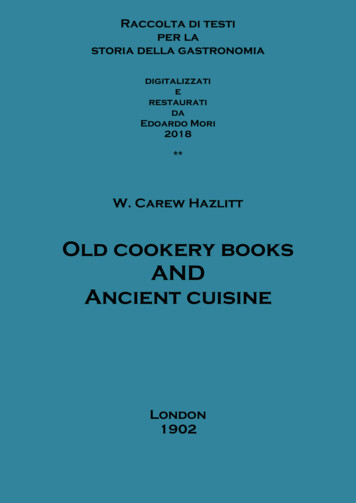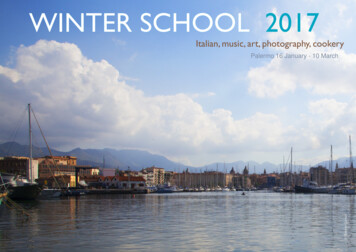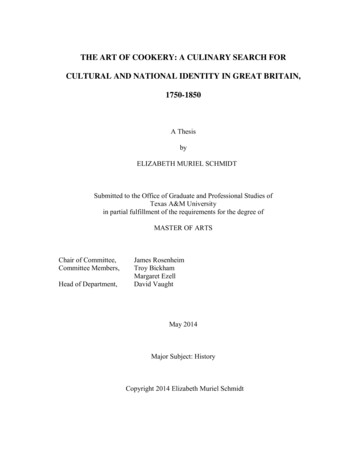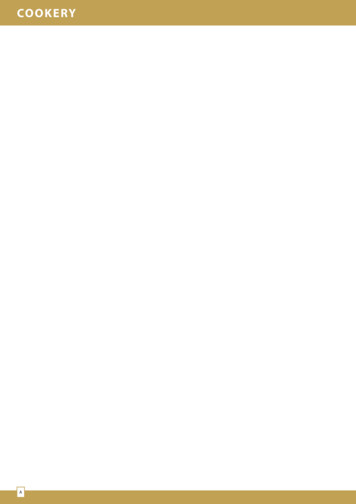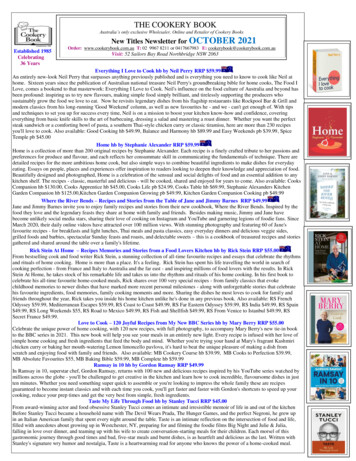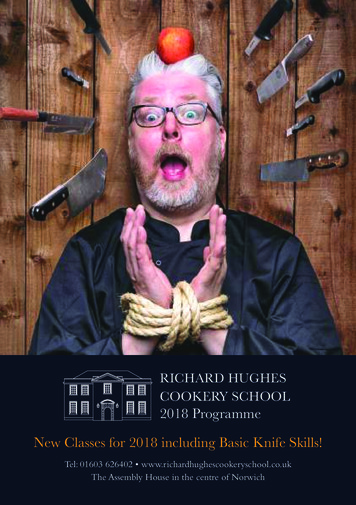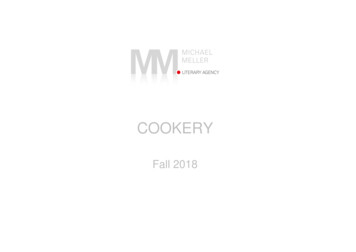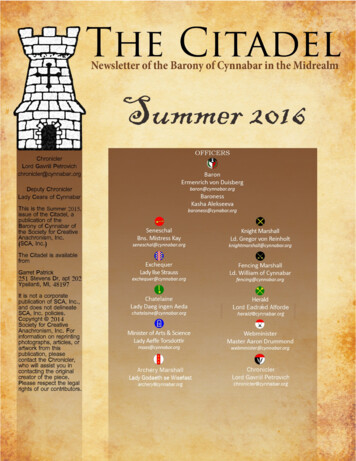
Transcription
Starting Points in CookeryThe WestBy THL Johnnae llyn Lewis, CEFor points West, we continue to “make the way around the compass rose acrossmedieval European history”, we examine “Sources for Recreating theShakespearean Era Feast” Again, this Starting Point guide is intended toprovide the reader with selected reliable sources with which to start one’sculinary adventures. Online sources are highlighted.Sources for Recreating the Shakespearean Era FeastWilliam ShakespeareApril 1564 – 23 April 1616April 2016 marked the 400th anniversary since thedeath of playwright William Shakespeare. As theSociety will be celebrating its own 50th anniversary inthis same year, it seemed appropriate to provide aselective list of original works combined with a listconcentrating on commercially published works whichmight inspire or provide reliable information forrecreating a Shakespearean era feast. When
constructing a feast menu or banquet menu for a table ofsweets, one should try to examine a selection of these worksfor variety sake and for comparison of recipes. The secondpart of this guide concentrates on aspects of Shakespeareanor Elizabethan life, foods, and feasts. These books all vary asto availability and price. Consider asking for them at a locallibrary or loaning them in before purchasing. For a listing oforiginal sixteenth century English printed editions, please seemy abbreviated initial list here or my other guides andbibliographies. Recipe counts are approximate.Original Works:Printing of cookery books in England begins in the year 1500.This selective list includes cookery books published in theShakespearean era or between 1564 and 1616. (It does notinclude dietaries and other associated works.) Many academiclibraries subscribed to and own copies of these works onmicrofilm through the UMI Microfilms Collection Project. TheUniversity of Michigan Library has long been associated withthe projects. Starting in the late 1990s, the microfilms werethen transferred as page images into the digital databaseknown as EEBO or English Books Online. If not at Michigan,
ask if your academic library participates and provides accessthrough EEBO. A few works have also been privatelytranscribed and appear online or in print. A few culinarymanuscripts are also included. This list concentrates onproviding the most easily accessible versions of a work, be itmicrofilm, print, or online. I am concentrating here on theeasiest way to locate a copy for use with emphasis on ease ofuse. For example, EEBO indicates it is online through theacademic library database Early English Books Online. [Foradditional information please consult my other checklists andbibliographies of English cookery books or contact me formore details.]Original Printed Cookbooks of the Shakespearean Era (5641616) include:1508 /1570THE BOKE OF KERVYNGE (CARVING)First printed in 1508 as Here Begynneth the Boke of Keruynge by Wynkyn deWorde, the work was reprinted in 1570 and was also included in whole or in part in ThomasDawson, A.W., John Murrell, Robert May, and William Rabisha. The 1570 is available onmicrofilm & EEBO. The 1508 is available in print as:The Boke of Keruynge: The Book of Carving. [Wynkyn de Worde, orig. printer. Edited byPeter Brears.] Lewes, East Sussex, U.K.: Southover Press, 2003. Facsimile.Online editions (other than Google Books) include the 1508 edition, which has beentranscribed by Daniel Myers. http://www.medievalcookery.com/notes/kervynge 1508.txt1545 /1575A PROPRE NEW BOOKE OF COKERY.The 1545 work was reprinted in 1575 and 1576 and is available on microfilm & EEBO.Online editions include:Frere’s text (minus the notes) he 1575 is transcribed by Daniel 75.txt1558 /1568 Alessio. THE SECRETES OF THE REUERENDE MAYSTER ALEXIS OFPIEMOUNT.
Widely popular book of secrets, Alessio contains the first printed English recipe forsugar paste as well as additional confectionary recipes. See my articles listed in thebibliography for more information on this work. The 1568, 1580, and 1595 editions are onmicrofilm and EEBO, and the 1558, 1568, and 1580 editions are available as EEBO Editionsthrough Amazon. Otherwise:The Secretes of the Reuerende Mayster Alexis of Piemount. London, 1558. Norwood,N.J.: Walter J. Johnson, Inc. and Amsterdam: Theatrum Orbis Terrarum, Ltd., 1975. TheEnglish Experience Series.1975. #707.1573 Partridge, John. THE TREASURIE OF COMMODIOUS CONCEITS, & HIDDENSECRETS AND MAY BE CALLED, THE HUSWIUES CLOSET, OF HEALTHFULLPROUISION.There are three culinary works generally associated with John Partridge who “flourished1566-1573.” Reference sources vary widely as to dating, number of editions, and even thegiven wording/spelling of the titles. These books were reprinted well into the mid 17 th century,and were revised, rearranged, and enlarged as time passed. For more on Partridge and thisvolume, see my introduction in the online edition at medievalcookery.com. Online:Holloway, Johnna. THE TREASURIE OF COMMODIOUS CONCEITSThe 1573 edition has been provided as an online edition courtesy of JK Holloway. Seemedievalcookery.com It’s also indexed so it can be searched as part of the recipe database.1582 Partridge, John. THE WIDOWES TREASURESecond work by Partridge, it’s more medicinal than culinary with editions varying widely inspelling and ranging from between 96 pages to as many as 120 pages. The 1586(?), 1588,and 1595 editions are on microfilm and EEBO. The 1588 and 1631 editions are available asEEBO Editions through Amazon.1584A. W. or W., A.A BOOKE OF COOKRYEContaining ‘banqueting stuffe,’ A.W. is a good basic collection of recipes. The 1591edition titled A Book of Cookrye is widely cited by many authors. The two earliest editionsappear in 1584 and 1587; the 1594 was lost during WWII. The 1591 edition is availablethrough microfilm and on EBBO and is available as an EEBO Edition through Amazon. Seealso: The 1591 is online at: http://jducoeur.org/Cookbook/Cookrye.htmlW., A. A Book of Cookrye With the Serving In of the Table. London 1591. Norwood, N.J. :Walter J. Johnson, Inc. and Amsterdam: Theatrum Orbis Terrarum, Ltd., 1976. The EnglishExperience Series. 1976. #834.1584/1585?Dawson, Thomas. THE GOOD HUSWIFES IEWELL and THE SECONDPART OF THE GOOD HUSWIUES IEWELL.Dawson provides two works, both of which are commonly used and cited. The first volume is
recorded in Stationers’ Register in December 1584, but there are no surviving copies frombefore 1587. It’s commonly accepted that it was printed because in 1585 a volume titled THESECOND PART OF THE GOOD HUSWIUES IEWELL appeared. No one really believes thatthe Second Part actually came first so there must be at least one missing edition of the GHJdated before the earliest surviving edition of 1587. Spelling varies because of the use of i andj in the word jewel. Editions of the GHT include: 1587, 1605, 1610, 1620, 1629, 1634, & 1650.The 1587 and 1596 GHJ is on microfilm and on EEBO. The 1596 GHT is transcribed byDaniel Myers and appears online. E SECOND PART OF THE GOOD HUSWIUES IEWELL appears in 1585. The 1597appears on microfilm & on EEBO and is also online at:http://home.comcast.net/ morwenna/Cooks/dawson2.htmlCombined editions of both appear in:Dawson, Thomas. The Good Huswifes Jewell. 2 Parts. London 1596/97. Norwood, N.J. :Walter J. Johnson, Inc. and Amsterdam: Theatrum Orbis Terrarum, Ltd., 1977. The EnglishExperience Series. 1977. #865. Contains the 1596 RSTC 6392 edition and the 1597 RSTC6395 Second Part.Dawson, Thomas. The Good Housewife’s Jewel. Introduction by Maggie Black. Lewes, EastSussex, U.K.: Southover Press, 1996. The unnamed editor took both parts of the originalbooks and recombined the recipes into modern sub-sections, all without noting in whichoriginal book in which the recipes appeared. Is a version from GHJ or GHJ-2? The text hasalso been tinkered with as to wording and spelling. Highly problematic to use and cite.1588Anon.THE GOOD HOUS-WIUES TREASURIE.This appears to be the only edition of this small work. It contains 33 culinary recipes, 11 morefor the preserves and sweets plus 10 medicinal recipes. I am at present editing andannotating this volume for publication at medievalcookery.com.The 1588 is on microfilm& on EEBO.1594 Anon. A GOOD HUSWIFES HANDMAIDE FOR THE KITCHIN. [A BOOKE OFCOOKERIE, OTHERWISE CALLED THE GOOD HUSWIUES HANDMAID.]May date from 1588. Title varies. The 1594 and 1595/97? are on microfilm and EEBO. The1594 edition is available as an EEBO Edition through Amazon.The Good Huswifes Handmaide for the Kitchen. A Period Recipe Book. Edited by StuartPeachey. Bristol, U.K.: Stuart Press, 1992.Online at: http://www.uni-giessen.de/gloning/ghhk/ with notes by Sam Wallace or tm1596Partridge, John. THE TREASVRIE OF HIDDEN SECRETS. COMMONLIE
CALLED THE GOOD HUSVVIUES CLOSET OF PROUISION.This is Partridge’s earlier titled TREASURIE OF COMMODIOUS CONCEITS, &HIDDEN SECRETS revised and released under the somewhat simpler title. Spelling variesfor “treasury.” There are numerous later editions for this work, including 1608, 1627, 1633,1637, 1638, & 1653. The 1596 and 1600 editions are on microfilm & on EEBO. The 1627 and1637 editions are available as EEBO Editions through Amazon. Also see:Partridge, John. A Treasury of Hidden Secrets. A 17th-century Housewives' Handbookof Cookery and Medicine. Cambridge, MA.: Rhwymbooks, 2002. This is the 1653edition that is being reproduced.The above 1653 volume is now online e.htm1598EPULARIO, OR THE ITALIAN BANQUET“Translated out of Italian into English.” This is a translation of the Italian work Opera novachiamata Epulario. It’s really an English version of Martino’s recipes, which Platina famouslypublished in the 1470s. It’s often listed as being by Anonymous or under Rosselli, Giovannede who was one of the translators. The one English edition is on microfilm, EEBO, and as anEEBO Edition through Amazon. Otherwise:Epulario, or the Italian Banquet. Printed by A.I. for William Barley, 1598. Reprinted byFalconwood Press, 1990. Sold at SCA events and in many collections.1600 Plat, Hugh, Sir. DELIGHTES FOR LADIES, TO ADORNE THEIR PERSONS,TABLES, CLOSETS, AND DISTILLATORIES.Platt or Plat is one of my favorite authors and is the subject of a new biography by MalcolmThick. King James I knighted him in 1605 for his various works. DELIGHTES FOR LADIES isjust a marvelous work for anyone interested in sweets and banqueting fare. Malcolm Thick’sPPC essay and Plat biography makes the case that Plat’s source for many of the generalrecipes came from a much earlier manuscript by a T.T., which is dated 1559-1561. The FolgerLibrary owns and often displays an early edition of 1608 edition. The 1948 charming Fusselledition reproduces the text of the 1609 edition. The Liz Seeber facsimile of the 1628 edition isjust gorgeous. Other editions are 1605, 1608, 1609, 1611, 1615, 1617, 1628, 1632, 1636,1640, 1647, 1654, and 1656. The 1600, 1602, and 1603 are on microfilm and on EEBO. The1608, 1611, and 1640 editions are available as EEBO Editions through Amazon. Otherwise,Plat, Hugh, Sir. Delightes for Ladies.1609. Edited by G.E. & K.R. Fussell. London: CrosbyLockwood & Son Ltd., 1948, 1955. This is the edition most people in the Society use and citewhen talking about Plat’s Delightes.
Note: The Trovillion Press in Illinois in 1939 and in 1942 produced a very limited fine pressedition of the 1627 edition titled Delightes for Ladies. Written Originally by Hugh Plat.First Printed in 1602 London England. The title turns up in Midwest libraries and inantiquarian catalogues.Online: There’s an extract from the 1602 edition owned by the British Library 08 A CLOSET FOR LADIES AND GENTLEVVOMEN. OR, THE ART OF PRESERVING,CONSERVING, AND CANDYINGMy annotated and edited version of this important confectionery text with all the details ofseventeenth century editions may be found here:A Closet for Ladies and Gentlewomen. 1608. Edited by Johnna Holloway. 2011 Web.Medievalcookery.com http://www.medievalcookery.com/etexts.html1615 Gervase Markham. THE ENGLISH HUSWIFE [THE ENGLISH HOUSEWIFE]Gervase Markham made his living as an author and translator in an age when authors were illpaid and ill-treated. Many of his works were on the care and training of horses. Markham’sfamous work The English Housewife first appeared as part of his volume CountreyContentments in 1615. It then appeared as part of his volume A Way to Get Wealth in1623.Markham continued to revise the work and it appeared again in 1631 as The EnglishHuswife in 1631. The work on the duties and virtues of a country housewife made its way tocolonial America and has long been a Society favorite. I recommend the following annotatededition:Markham, Gervase. The English housewife: containing the inward and outward virtueswhich ought to be in a complete woman, as her skill in physic, cookery, banquetingstuff, distillation, perfumes, wool, hemp, flax, dairies, brewing, baking, and all otherthings belonging to a household. 1631. Edited by Michael R. Best. Kingston: McGillQueen’s University Press, 1986.1615 John Murrell. A NEW BOOK OF COOKERYJohn Murrell is the author of a number of interesting culinary works appearing for the first timebetween 1615 and 1628/1629 when the first edition of his Murrells Two Books of Cookeryappeared. The 1615 is available on microfilm, EEBO, and as an EEBO edition on Amazon. Ofinterest to Society members are his A Daily Exercise for Ladies and Gentlewomen (1617)and A Delightful Daily Exercise (1621), which contain recipes for sweets and banquetingitems.Later Printed or Online Editions of Shakespearean Era Manuscripts include:
1567The Commonplace Book of Countess Katherine Seymour Hertford(University of Pennsylvania Ms. Codex 823) Daniel Myers (transcr.)Transcription is online at medievalcookery.comc.1550-1625Martha Washington’s Booke of Cookery. Edited with commentary by Karen Hess. NewYork: Columbia University Press, 1981. A transcription of “A Booke of Cookery”and “A Bookeof Sweetmeates,” from a manuscript owned at one time by Martha Washington. Hess datesthe recipes as being Elizabethan-Jacobean dating from c1550-1625 and provides extensivenotes and bibliography. Paperback edition also available. Highly recommended.1580-1612Tollemache, Catherine. Manuscript and accounts published in part as Fruitful Endeavours.The 16th Century Household Secrets of Catherine Tollemache at Helmingham Hall.Edited by Moira Coleman. Andover, UK: Phillimore & Co, 2012. A work of household secretsand recipes with notes and historical material provided by the editor.c.1604-18th centuryFettiplace, Elinor. Elinor Fettiplace’s Receipt Book: Elizabethan Country House Cooking.Edited by Hilary Spurling. London: The Salamander Press and and New York: VikingSalamander, 1986. Classic Society source featuring a selection of Elizabethan and Jacobeanrecipes from a household manuscript (begun in 1604) with adaptations and commentary. Alsoincludes several post-Restoration recipes, such as a “chocolate cream.” The full manuscripthas been published as in the next entry.The Complete Receipt Book of Ladie Elynor Fetiplace. Bristol, England: Stuart Press. 3volumes. Volume I: 1994. Volume 2 [titled: The Complete Elinor Fettiplace’s Receipt Book]:1999. Volume 3 [titled as volume 1]: 1999. A three volume set reproducing the entire Fetiplaceor Fettiplace manuscript. Spurling published only a selection. http://www.stuarthmaltd.com/living history medicine.php lists the set.c.1610“Mrs. Sarah Longe Her Receipt Booke, c1610.” Caton, Mary Anne, ed. Fooles andFricassees: Food in Shakespeare’s England. Washington, D.C.: The Folger ShakespeareLibrary, 1997. Appendix I. pp.99-119. An original publication of a ‘literal transcription of ac1610 manuscript’ with an introduction by Heidi Brayman Hackel.c. 1614Castelvetro, Giacomo. The Fruit, Herbs & Vegetables of Italy. Translated by Gillian Riley.London: Viking, 1989. Revised edition. Prospect Books, 2012. Castelvetro escaped the ItalianInquisition to settle in England where he wrote his manuscript about the English diet &lamenting the loss of the fruits and vegetables of his Italian upbringing.Gateway to Online Materials.
Need original Elizabethan cookbooks? The websiteMedievalcookery.com provides an easy way to numeroushistorical and original English works, including a number of16th century and early 17th century cookbooks. TheMidrealm’s Master Edouard Halidai (Daniel Myers) createdand operates the invaluable site.Works with Substantial Numbers of AdaptedShakespearean/Elizabethan Recipes:Beebe, Ruth Anne. Sallets, Humbles & Shrewsbery Cakes. Boston: David R. Godine, 1976.Released again in paperback by David R. Godine, 2002. 60 recipes. Original recipes from 4works are included but not labeled, leaving readers to determine the source. Not essentialthese days.Brears, Peter. All the King's Cooks. The Tudor Kitchens of King Henry VIII at HamptonCourt Palace. London: Souvenir Press, 1999. Paperback ed. 2011. Excellent text with 82recipes from 16th century England. With photos and drawings. Highly recommended. Kindleedition also available.Brears, Peter. Cooking and Dining In Tudor and Early Stuart England. London: ProspectBooks, 2015. 670 pp., 141 B/W line drawings/figures. [Notes: 613-632. Bibliography: 633-641.Indexes [both general and recipes]: 642-670.] Marvelous new companion volume to Brears’award winning Cooking & Dining in Medieval England. 370 plus recipes and variations.Includes menus, calendar customs, banquets, banqueting fare. Etc. Essential and highlyrecommended volume.Dalby, Andrew and Maureen Dalby. The Shakespeare Cookbook. London: British Museum,2012. A well illustrated cookbook with approximately 40 practical recipes by the food historianAndrew Dalby and his wife Maureen. Consider purchase of a used volume or loaning a copyin. Hint: Peter Brears is a much better source.Fettiplace, Elinor. Elinor Fettiplace’s Receipt Book: Elizabethan Country House Cooking.Listed under manuscripts above. Contains adapted recipes.Lorwin, Madge. Dining with William Shakespeare. New York: Atheneum, 1976. A classicvolume with 434 pages featuring 13 menus. Including 186 original and working recipes andsuggestions for drinks. The recipes have been widely used and adapted for numerous Societyfeasts over the decades. Used prices are running around 5- 15. Well worth reading forquotations, inspiration and ideas. Consider purchase or loaning a copy in.
Morton, Mark and Andrew Coppolino. Cooking with Shakespeare. [Feasting with Fiction.]Westport, Ct: Greenwood, 2008. Given the wealth of material, one would have expectedbetter of this problematic work. It features a complicated layout. More than a few of the 189featured recipe adaptations come across as just plain wrong or unreliable. Interestingbibliography. Very expensive, so consider loaning in a copy.Sass, Lorna J. To the Queen’s Taste. New York: The Metropolitan Museum of Art, 1976. Thiswas Sass’s follow-up to the volume To the King’s Taste. It features Elizabeth I. 40 recipeswith the same faults found in her previous volume. A bit antiquated by this point.Zyvatkauskas, Betty & Sonia. Eating Shakespeare. Recipes and More fromthe Bard’s Kitchen. Toronto: Prentice Hall Canada, 2000. The paperback [ISBN0130894524] was released in 2002 by Prentice Hall Canada. Little knownCanadian publication, but well worth the bother of seeking out. 96 recipes. Usedcopies are currently very inexpensive.English HeritageThe historical association first published a set of paperbacks examining cookery inBritain in 1985. Titles could be purchased as a boxed set or individually. Ofinterest to readers here are the titles Food and Cooking in 16th CenturyBritain: History and Recipes and Food and Cooking in 17th CenturyBritain: History and Recipes. Over the years these volumes have beentinkered with, combined, photos added, and re-released in a number of formatsand titles.A Taste of History. Edited by Peter Brears, Maggie Black, et al. London: English Heritage;British Museum Press, 1993, 1994. Paperback edition, 1997. Combined edition of all theEnglish Heritage pamphlets from 1985.Brears, Peter. Stuart Cookery. Recipes and History. [London:] English Heritage, 2004.New edition of Brears’ work on 17th Century Britain. Attractive new photos along with 21recipes. Superseded by Brears’ newer works but still worthwhile for those interested in earlyJacobean or Shakespearean fare.Brears, Peter. Tudor Cookery. Recipes and History. [London:] English Heritage, 2003. Newedition of Brears’ 1985 English Heritage work on the 16 th Century. Attractive new photos alongwith 26 recipes.Making a Meal of It. Two Thousand Years of English Cookery. Swindon, UK: EnglishHeritage, 2005. Another reworking of the 1985 English Heritage series of cookery booklets.
Also Consider:Albala, Ken. Cooking in Europe 1250-1650. Westport, Conn.: Greenwood Press, 2006. 42original English recipes. No adapted recipes but lots of notes and discussions aboutingredients and techniques.Brears, Peter. Cooking and Dining In Medieval England. Totnes, Devon, UK: ProspectBooks, 2008. Paperback ed. 2012. This is Peter Brears’ award winning volume on Englishmedieval cookery.Brears, Peter. “Rare Conceits and Strange Delightes: The Practical Aspects of CulinarySculpture.” ‘Banquetting Stuffe’. The Fare and Social Background of the Tudor andStuart Banquet. [Food and Society 2.] Ed. By C. Anne Wilson. Edinburgh: EdinburghUniversity Press, 1991. pp.60-114. In this widely cited article, Peter Brears offers 39 workingrecipes for recreating a proper Elizabethan or Jacobean banquet table of sweets. Most nowappear in Brears’ 2015 volume Cooking and Dining In Tudor and Early Stuart England.Castelvetro, Giacomo. The Fruit, Herbs & Vegetables of Italy. Translated by Gillian Riley.London: Viking, 1989. Revised edition by Prospect Books, 2012. Listed under manuscriptsabove.David, Elizabeth. English Bread and Yeast Cookery. 1977 UK; 1980 USA.Authentic bread recipes are hard to come by, and David is still the place to begin for thosethat want to explore English baking, the flours, the mills, the bread ovens, and the recipes.Numerous British and American editions. The UK original edition was newly reissued 2001and again in hardcover in 2010. The original US edition was edited by food historian KarenHess who added her own foreword.Fleming, Elise. Confections and the English Banquet. [Series: The Compleat Anachronist.#163 2014:3] Covers the “banquet” ranging from its evolution through the development of thebanqueting house, a brief history sugar and confections, table layouts, common banquetitems, spice dishes, trenchers, and forks, leading into a conclusion on page 22. The rest ofthe pamphlet is comprised of Appendices covering lists of banqueting items, recipes, asection on recreating a banquet, and lastly, sugar stages.Martha Washington’s Booke of Cookery. Edited by Karen Hess. New York: ColumbiaUniversity Press, 1981. Listed under manuscripts above.Numerous other works include material or sections on Elizabethan or Shakespearean dining.Sara Paston-Williams’ The Art of Dining: A History of Cooking & Eating. New York: HarryN Abrams, 1994 is one. The recipes were then published as A Book of Historical Recipes in1995. The unrevised edition then appeared in the fall of 2012. Those traveling to the UK maychance upon such items as: The Tudor Kitchens, The Tudor Kitchens Cookery Book, andThe Taste of Fire all from Hampton Court Palace. Michelle Berriedale-Johnson has includedElizabethan recipes in the British Museum’s Festive Feasts Cookbook. Michele Brown alsoincluded them in Royal Recipes. Anne Willan’s Great Cooks and Their Recipes firstappeared in 1977. Revised and expanded, it features the 17 th century work of Robert Mayamong others. With recipes and great pictures of recreated dishes. Good for inspiration.
Those coming across a title The Little Book of Shakespeare and Food by Domenica deRosa, 2001, should be aware that the work contains Shakespearean quotations but onlymodern recipes. Likewise, Francis & Hober’s Cooking with Shakespeare (1989) is adramatic approach with inauthentic recipes. The Food of Love. The Taste of Shakespearein Four Seasons. Glasbury-on-Wye, Powys, UK: Graficas Books, 2012 is another work withinauthentic recipes. One would expect to see more works with recipes suggested byShakespeare as the Anniversary creates a ready market. Be wary!ALSO NOT RECOMMENDED: The following is not recommended.Segan, Francine. Shakespeare’s Kitchen. Renaissance Recipes for the ContemporaryCook. New York: Random House, 2003. There are many and various reasons why this workis not recommended, including her lazy habit of just labeling generic recipes, as a“Renaissance” version. See the 2004 Tournaments Illuminated review for why!The small print or caveatsThe modern historical cookbooks included in the above list feature modernized adaptations orworking recipes that are more or less appropriate for Society occasions; many are alreadymentioned in SCA articles and websites or found in many Society collections. The best ofthese works either include the original recipes along with the modern versions or list theoriginal recipe source along with the working versions. The modernized recipes are suitablefor most beginners and moderately advanced cooks, but they may not be 100 per centauthentic as to ingredients and therefore may be unsuitable for authentic item or A&S entries.Read the original and working recipes carefully before beginning any Shakespearean cookeryproject. These published adapted recipes in many instances can readily serve as startingpoints for readers or cooks until readers gain the experience necessary to plunge into theactual original culinary texts and redact their 100% own authentic working versions.Works with Information on the Shakespearean and Elizabethan Table, Foods, Customs, andLife These are primarily academic works, but readers may find them valuable for backgroundmaterial and insights.Albala, Ken. Eating Right in the Renaissance. Berkeley: University of California Press,2002. All the numerous dietaries on what to eat are explained in this volume, making this thebest book on dietary advice in the Renaissance.Albala, Ken. Food in Early Modern Europe. Westport, CT: Greenwood Press, 2003. More orless a textbook but a well done one on food history. Starts at 1500, so it covers the Voyagesof Discovery and what was introduced to Europe in the 16 th century, like the turkey andpumpkins.Bates, Jonathan & Dora Thornton. Shakespeare. Staging the World. Oxford: OUP andLondon: The British Museum Press, 2012. New heavily illustrated volume examining the playsand life in London during Shakespeare’s lifetime and especially the year 1612.Bennett, Jackie. Shakespeare’s Gardens. London: Frances Lincoln Limited, 2016. A very
nice edition with photos of gardens in and around Stratford.Brears, Peter. “Decoration of the Tudor and Stuart Table.” The Appetite and the Eye. [Foodand Society 2.] Ed. By C. Anne Wilson. Edinburgh: Edinburgh University Press, 1991. pp. 5697.Breverton, Terry, compiler. The Tudor Cookbook. From Gilded Peacock to Calves’ FeetJelly. Stroud, UK: Amberley, 2016. A straight-forward compilation of original recipes. Doesthank and mention Society websites.Brown, Peter B. and Ivan Day. Pleasures of the Table. Ritual and Display in the EuropeanDining Room 1600-1900. York, U.K.: York Civic Trust, 1997.Caton, Mary Anne, ed. Fooles and Fricassees: Food in Shakespeare’s England.Washington, D.C.: The Folger Shakespeare Library, 1997. Exhibit catalog with pictures.Includes the original publication of a ‘literal transcription of a c1610 (culinary) manuscript’ inAppendix I. pp. 99-119.Christmas in Shakespeare’s England. Compiled by Maria Hubert. Stroud, Gloucestershire,UK: Sutton Publishing, 1998. ISBN: 0-7509-1719-9. Great book for planning a Yule eventcentered on Shakespearean times. Out of Print. Consider a loan.Cooper, Tarnya. Searching for Shakespeare. New Haven: Yale University Press, 2006.Dawson, Mark. Plenti and Grase: Food and Drink in a Sixteenth-Century Household.Totnes, Devon, U.K.: Prospect Books, 1998. A discussion of the food and drink consumed bythe Willoughby family, the owners of Wollaton Hall In Nottingham & Middleton Hall inWarwickshire. Based on household accounts.Day, Ivan. Royal Sugar Sculpture. 600 Years of Splendour. Barnard Castle, Durham, U.K.:The Bowes Museum, 2002. Contains material on historic sugar molds, recipes, and sotelties.Sugar paste first appears in the 1550s, making it highly appropriate for the Shakespeareantable. http://www.historicfood.com/portal.htm is Ivan Day’s wonderful website. His blog FoodHistory Jottings is at foodhistorjottings.blogspot.com/One of his YouTube contributions is “Supper with Shakespeare: The Evolution of EnglishBanqueting” which highlights an exhibit from the Minneapolis Institute of Arts in 2012.https://www.youtube.com/watch?v qebdv6yH2B8See ties-ivan-day.htmlEat, Drink, and Be Merry. The British at Table 1600-2000. Edited by Ivan Day. London:Philip Wilson Publishers, 2000. 96 color and b/w illustrations and photographs. Features aJacobean style banquet table of sweets and pastries.The Elizabethan Garden at Kenilworth Castle. Edited by John Watkins and AnnaKeay. Swindon, UK: English Heritage, 2013. Covers the key aspects, background, and historyof the recreation of the Elizabethan gardens at Kenilworth.The English Cookery Book. Historical Essays. Edited by Eileen White. Totnes, Devon,U.K.: Prospect Books, 2004.
The English Kitchen. Historical Essays.
Printing of cookery books in England begins in the year 1500. This selective list includes cookery books published in the Shakespearean era or between 1564 and 1616. (It does not . This is a translation of the Italian work Opera nova chiamata Epulario. It's really an English version of Martino's recipes, which Platina famously
